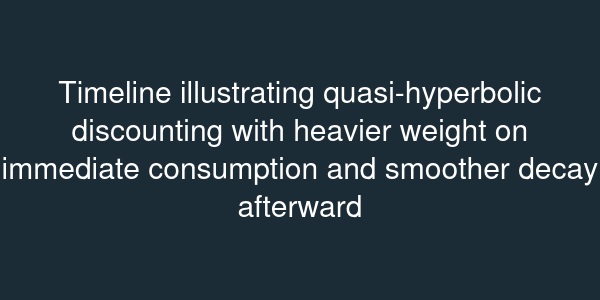Hyperbolic Discounting
Essential Questions
- How does the β-δ model capture present-biased preferences?
- What evidence shows dynamic inconsistency in savings and health decisions?
- Which policy tools align short-run impulses with long-run goals?
Overview
You promise yourself to start studying early, yet find yourself cramming the night before. Retirement savers vow to increase contributions but delay. Hyperbolic discounting quantifies this present bias. By adjusting the discount factor for immediate outcomes, the β-δ model explains procrastination and demand for commitment devices.
This lesson introduces the math of quasi-hyperbolic discounting, demonstrates preference reversals with numerical examples, and evaluates policies like Save More Tomorrow and gym contracts.
The β-δ Framework
Quasi-hyperbolic preferences evaluate a consumption stream with utility where captures present bias and is the long-run discount factor. When , immediate rewards receive extra weight. For example, with , , and , the individual values at . Waiting a day to evaluate the same plan yields , reversing the preference.
Dynamic inconsistency appears because the "future self" plans using , while the "present self" uses for tomorrow's outcomes. The Euler equation modifies to for , but for . The marginal condition changes as you roll forward.

Evidence of Present Bias
Field experiments with 401(k) plans show employees committing to higher savings rates in the future but not today. Thaler and Benartzi's Save More Tomorrow program exploits this: participants agree to auto-increase contributions when they receive raises. Gym contracts also reveal present bias; DellaVigna and Malmendier found members choosing monthly plans at $70 even though per-visit costs exceeded pay-as-you-go prices because they planned to attend frequently but failed to follow through.
Health behaviors echo the pattern. Smoking cessation programs with deposit contracts—where participants forfeit money if they fail to quit—demonstrate demand for commitment devices. In development economics, microcredit borrowers accept reminders and social pressure to repay on time, highlighting awareness of self-control problems.
Policy and Design
To address present bias, policymakers and firms introduce commitment tools: automatic enrollment in retirement plans, deadlines for college financial-aid forms, or goal-based budgeting apps. Mathematically, you can model commitment as altering the feasible set so that the present self cannot deviate. For example, adding a constraint enforces savings.
Understanding hyperbolic discounting also informs welfare analysis. Traditional cost-benefit analysis uses exponential discounting, potentially undervaluing short-run utilities that people overemphasize. Incorporating β-δ preferences helps calibrate subsidies, taxes, or reminders that align immediate incentives with long-term welfare.